#knight of cerebus
Explore tagged Tumblr posts
Text
The SECOND Best Trope Ever Showdown: Round 1, Side C, Poll 4
Knight of Cerebus
A new character, usually an antagonist, who marks the transition to a darker tone for the work.
Propaganda:
Because wits super funny whenever the show has a light goofy feel to it and then suddenly this character comes in and completely changes the vibe!
Take a Third Option
A character presented with 2 choices finds a way to choose a third thing instead (or something just a character presented with [x] number of choices finds a way to choose something that hasn't been presented to them as an option]
Propaganda:
I will admit when done badly it can be annoying and feel like a cop out to have a character swerve and make an ending or plot point feel really out of left field, but when well done it can be soooo satisfying, to watch a character think their way out of a seemingly limited situation and/or demonstrate that a false choice has been set before them and take control of their own narrative
17 notes
·
View notes
Text

THERE IS STILL TIME FOR YOU TO MAKE HISTORY! Did you miss out on the LEGENDS OF INDIE COMICS: WORDS ONLY Kickstarter campaign? The one that's making history by bringing together some of the most legendary characters and creators of the indie comics era in a book of thrilling prose fiction adventures? Well, this is your lucky day! The LEGENDS OF INDIE COMICS project is accepting late pledges, so there's still time for you to leap in, be all historic, and snag some spectacular rewards! Here's the link: http://kck.st/3Y11ZHu
Remember, thanks to the stretch goals, the book will include a DYNAMO JOE story, a SOUTHERN KNIGHTS tale, and black-and-white illustrations to accompany every story! And every backer will get a digital copy of the companion book, LEGENDS OF INDIE COMICS: HISTORY AND TRIVIA.
Don't hesitate to jump in and help us make this book the absolute best it can be...all while scooping up fabulous rewards! JOIN THE LEGENDS OF INDIE COMICS!
#kickstarter#comics#first comics#mike baron#joe staton#indie comics#crowdfunding#southern knights#dynamo joe#badger#concrete#paul chadwick#mike grell#dave sim#cerebus#mr. monster#michael t. gilbert#grimjack#john ostrander#justin jordan#luther strode#desert peach
3 notes
·
View notes
Text
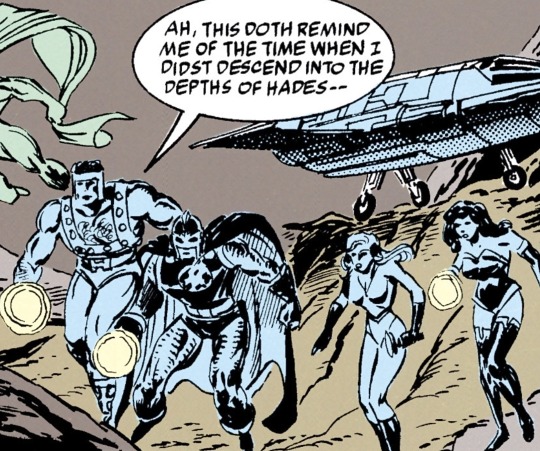
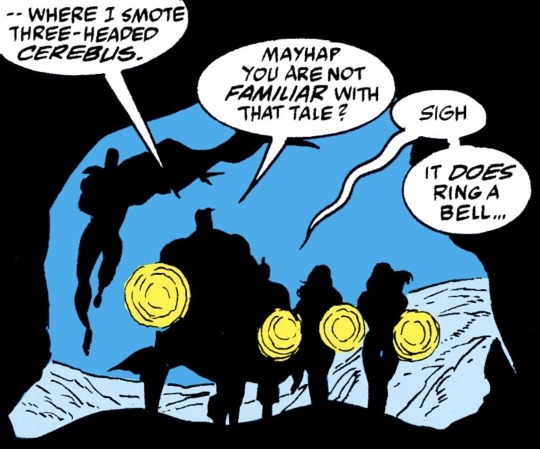
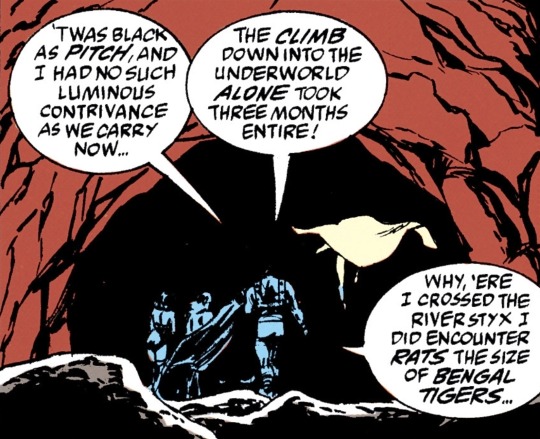
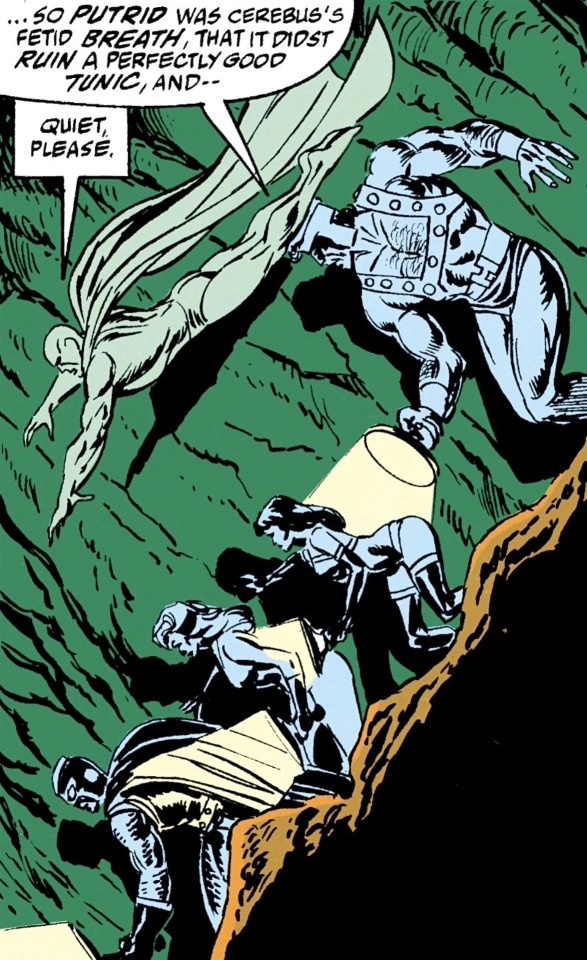
#avengers#storytime with#hercules#as he regales#black knight#sersi#crystal#and#white vision#with the tale of his descent into hades and his battle with#cerebus#marvel#comics
1 note
·
View note
Text
#this is why he rules #it's why of all the megatrons in the tv shows he's the one that feels Actually Threatening #bc he shows up intermittently wins half the time and is absolutely of the opinion he's Here To Murder #which sticks out so much. god bless. tfa megs is unhinged <3 (via decepti-thots)
Transformers Animated is so funny because specifically Megatron doesn't seem to be aware of the fact that he is in a kids' show. This man is taking everything so seriously. He goes for the kill all the time. He ignores all the 'this show is for kids' things around him. He spends an entire season as a cut off head and tries to kill the main cast at every moment anyway. Starscream betrays him again and he kills him. Starscream keeps coming back from the dead like a cartoon character? Megs kills him again. And again. Dumps his body out and goes back to serious business. Heroes keep attacking him? Fuck you he's bringing out a wholeass sword and a gun and he will use them. Never gonna forget the one time where Optimus saves him and then immediately after Megs picks him up and uses him as a shield. Everyone around him keeps doing and saying silly stuff for the funsies and he ignores them. Amazing. Irredeemable. He does not deal with cartoony stuff and mostly ignores anything that is like a kids show.
Like you could pick him up and plop him into TFP or IDW no problem, he's straight up a genocidal dictator. I love him and his non-silly ass
2K notes
·
View notes
Text
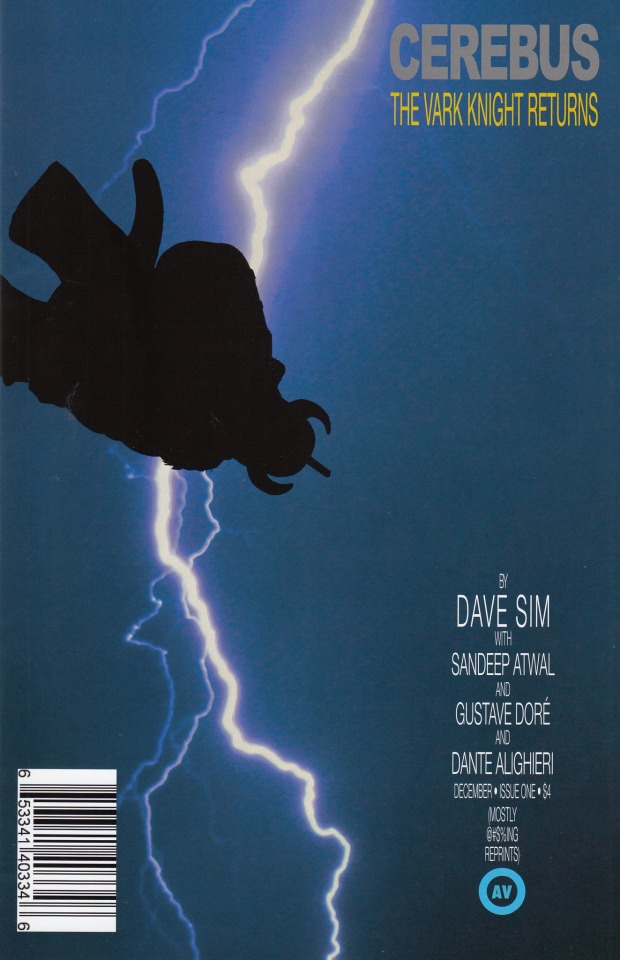
Cerebus in Hell? Presents #10
#Cerebus in Hell? Presents#cerebus#the dark knight returns#parody#dave sim#aardvark vanaheim#comics#2010s comics
1 note
·
View note
Text
I just had the mental image of Tarn in Earthspark.
Not as a "Knight of Cerebus" but as Megatron's stalker fanboy with far too much free time.
Megatron is just very clearly trying oh so hard not to vaporize this one REALLY annoying fanboy, and then Tarn just breaks down sobbing the first time he hears Dot causally call Megatron "Megs". Just one big whiny fanboy tantrum.
(Only tagging this as "djd tarn" so people know that I'm talking about Tarn the character and not Tarn the polity.)
15 notes
·
View notes
Note
Death Battle related sketch fight scene art request. Could you please in any artstyle you can draw no matter how it looks, could you please draw Mephiles the Dark (Sonic the Hedgehog 2006) versus Kurumi Tokisaki (Date A Live anime)? Death Battle connections they are both evil themed time travelers who can clone armies of themselves, have a signature scene where they stab people literally in the back, they have powers of darkness, turn the stories they're in for a darker Knight of Cerebus turn and are known for their sadistic laughter, they are also breakout popular villains of their universe.
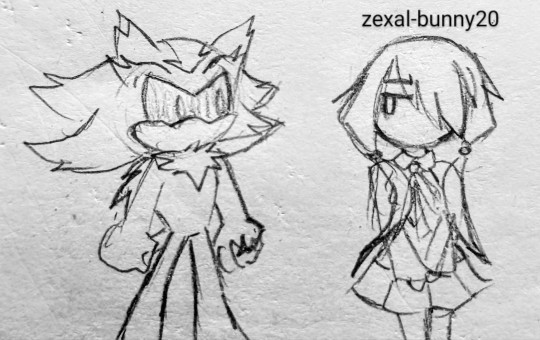
Uh... yeah. Okay. Here you go, have them as chibis. Thanks for the request.
4 notes
·
View notes
Note
Tong Pooh's role in Project X Zone. Strider villain representative character Tong Pooh's characterization is different than Saya and Vile's since unlike them Tong Pooh doesn't get the tear drop music when she is dying. No forced sympathy, but letting the audience knows she is doing bad things and has no regrets about the consequences in the long wrong helping an omnicidal scientist who borders on motivations on par with evil real life mad scientist Doctor Joseph Mengele on an Emperor Palpatine scale.
Tong Pooh knows she serves Grandmaster Meio fanatically out of something she did for Tong and her two other sisters. I theorize Tong Pooh and the siblings were an all female gang who were willing to hurt and kill people to survive eating food for scraps whether their victims were innocent or not. Meio impressed with their ruthless Social Darwinist mindset decided to raise them as his assassins and when they reached the matured age, granted them never aging immortality so they will help spread his name through conquest and the pained sorrows of his victims.
Grandmaster Meio was essentially Strider's answer to Samurai Jack Aku if he were a mad scientist ruling through planets with a despotic ironfist while everyone continuously suffer for it through his mad science experiments. And that's not even considering Dr Edward Bilstein from Star Gladiator the most evil Capcom villain on pair with Dr Weil from Megaman Zero. I do think Project X Zone and Namco X Capcom fanfiction writers should have Dr Edward Bilstein and Dr Weil team up to form an alliance since they are similar. I also believe Namco was unwilling to use Bilstein because he would be far too dark of a villain for them to use given how ruthless of a Knight of a Cerebus Bilstein really is in his universe. Let it be known there already is an existing future in his canon game where Bilstein won and it required time travel from Jun Lin Milliam's daughter in hopes to subvert this bad future from happening again.
Yeah that's an interesting idea to include, too bad Project X Zone chooses to not do that because they rather weaponize the IPs rather than making a good SRPG at least if you ask me
3 notes
·
View notes
Photo

Spark Gym Leader: Chili Concarne
Finally, we have a design for a character I should have gotten to a LONG time ago, but here's my take on the first gym leader and Knight of Cerebus within A Single Spark, Chili! Be sure to read my Nuzlocke comic here!
Posted using PostyBirb
5 notes
·
View notes
Text
The Best Trope Ever Showdown: Round 1, Side A
Knight Of Cerebus
Propaganda:
This trope is responsible for some of the most terrifying villains that I have seen including Death from Puss in Boots, Belos from The Owl House and the Lich from Adventure Time
Prophetical Semantics
Made its debut in McBeth, a character is bound by a curse or prophecy and is freed from it by unconventional means, usually due to the specific wording used (no TVTropes link submitted)
Propaganda:
DO YOU FORGET EOWYN’S “I AM NO MAN”?!? Put some respect on her name!!! There are so many fun creative ways to use this trope! Naveen “kissing a princess” by marrying Tiana! “No weapon forged by mortal hands can kill me” and being bludgeoned by a rock! As long as you do the setup, you can twist the plot without it feeling cheap! I love it!
52 notes
·
View notes
Text
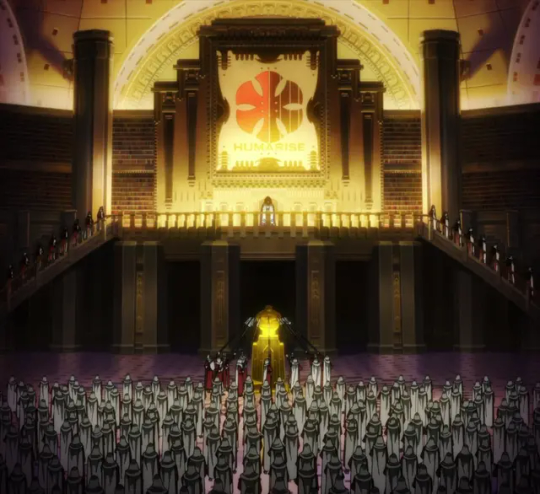
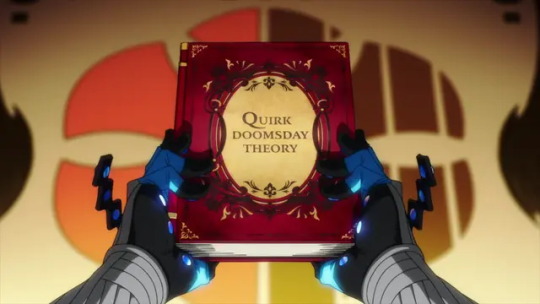
Humarise and Bliss Ocean are both fictional organizations with extremist ideologies, but they originate from different series and have distinct targets and methods. Humarise, from My Hero Academia, is a cult against Quirks, while Bliss Ocean, from Epithet Erased, is a terrorist group against Inscribed (Epithet users).
Humarise: Analysis, Motives, Skills, and How it Works
Humarise is an international cult in
My Hero Academia that holds the radical belief that Quirks are a "disease" that must be eradicated for humanity's survival. They refer to Quirk users as "diseased" or "infected" and the Quirkless as "pure humans".
Motives: Their primary motive is a genocidal purge of all Quirk users to achieve what they perceive as "humanity's survival". They are willing to carry out global terror attacks to achieve this.
Hypocrisy: Despite their anti-Quirk ideology, many Humarise members possess Quirks themselves. While some, like the Serpenters, join to avoid being culled, and Beros genuinely believes in their philosophy, the motivations for other Quirk users to join are not fully known. This makes them hypocritical.
Skills/Operations:
They employ "Elite Mooks" who are Quirk users, enabling them to better contend with Pro Heroes.
Their operations include global terror attacks and threatening the lives of scientists' children.
The organization is depicted with "absolutely zero comical qualities" and serves as a "Knight of Cerebus" in their respective film, highlighting their dark and serious nature.
Inspiration: Humarise is noted as an Expy of the Purifiers from X-Men, sharing a church motif, uniform, and a genocidal crusade against those with superpowers, despite allowing some powered individuals into their ranks.
Bliss Ocean: Analysis, Motives, Skills, and How it Works
Bliss Ocean is a "mundie terrorist group" located in Sweet Jazz City in
Epithet Erased. They harbor a "deep hatred against Inscribed" (those with Epithets/superpowers) and aim to eliminate all Epithets for an "equal society". They are known to have an interest in the Arsene Amulet, likely due to their vendetta.
Motives: Their core motivation stems from the belief that Epithets create unfair advantages. As Zora Salazar, a high-ranking member, puts it, a "mundie" (Quirkless individual) could train tirelessly, yet their skills could be easily surpassed by someone simply born with a superpower. They desire an "equal society" achieved by getting rid of Epithets.
Skills/Operations:
They are a "nebulous evil organization" with many details unknown.
They consist of both mundies and Epithet users who share similar ideals.
They actively seek and attempt to retrieve artifacts like the Arsene Amulet.
Their leader is enigmatic, appearing as a silhouette.
Notable members like Zora Salazar (Rank 3 Corps Officer) are incredibly powerful, capable of rapid aging and time manipulation, and can imbue her Epithet into objects. Yoomtah Zing is an errand girl with implied electrical powers and stealth expertise. Moot Tarbella is a mysterious hooded member.
Their leadership ranks with power; Zora joined after being convinced by a "one-sided" fight against the leader.
Hypocrisy: Similar to Humarise, Bliss Ocean includes Inscribed members despite their anti-Epithet stance. Zora Salazar, for instance, is an Inscribed member who hates Epithets because she believes they make skill competitions inherently unfair, yet she also flaunts her own Epithet's superiority.
Similarities and Differences
Similarities:
Anti-Power Ideology: Both organizations share a core ideology that targets superpowers: Humarise targets Quirks , and Bliss Ocean targets Epithets.
Hypocrisy: Both groups exhibit hypocrisy by having members who possess the very powers they seek to eradicate.
Extremist Methods: Both are terrorist groups willing to employ extreme and violent methods to achieve their goals, including global terror attacks for Humarise and implied widespread actions for Bliss Ocean.
Hierarchical Structure: Both organizations have clear leadership structures and notable members.
Dark Tone: Both are presented as serious, non-comical antagonists in their respective narratives.
Differences:
Originating Series: Humarise is from My Hero Academia , while Bliss Ocean is from Epithet Erased.
Specific Target: Humarise targets "Quirks" , while Bliss Ocean targets "Epithets" or "Inscribed".
Motivation Nuance: Humarise's motive is framed as "humanity's survival" by purging Quirks. Bliss Ocean's motive is more explicitly tied to the perceived unfairness of superpowers in competition, aiming for an "equal society".
Known Leadership: Humarise's leader is implied throughout the document but not explicitly named. Bliss Ocean's leader is depicted as an enigmatic silhouette.
Specific Operations: Humarise carries out global terror attacks. Bliss Ocean has specific interests in artifacts like the Arsene Amulet.
#mha#mhashitpost#mhafandom#mha_fandom#mha_fndm#mha_post#mhapost#mha_comments#mha_villains#mha_posts#villains_mha#mha_foils#mha_groups#mha_faction#mha_group#mha_antagonists#mha_analysis#mha_meta#mha_theories#mha_theory#mha_anaylsis#MyHeroAcademia#MHAshitpost#MyHeroAcademiaFandom#MHAfandom#MHAfndm#MyHeroAcademiaPost#MHApast#MHAcomments#MHAvillains
0 notes
Text

BETTER LATE THAN NEVER! Did you miss out on the LEGENDS OF INDIE COMICS: WORDS ONLY Kickstarter campaign that ended last night? No worries! We are still accepting late pledges, so there's still time for you to leap in and snag some spectacular rewards! Here's the link: http://kck.st/3Y11ZHu
Remember, thanks to the stretch goals, the book will include a DYNAMO JOE story, a SOUTHERN KNIGHTS tale, and black-and-white illustrations to accompany every story! And every backer will get a digital copy of the companion book, LEGENDS OF INDIE COMICS: HISTORY AND TRIVIA.
Don't hesitate to jump in and help us make this book the absolute best it can be...all while scooping up fabulous rewards! Long live the legends of indie comics!
#indie comics#comics#80s comics#badger#cerebus#dave sim#mike baron#mike grell#joe staton#bob burden#flaming carrot#justin jordan#luther strode#southern knights#dynamo joe
0 notes
Text
Played SO3 this afternoon. Thank god I continued the story on a weekend bc I hated the Sealed Caverns/Shrine of Kaddan and i hated how Maria's backstory was done lol. Thoughts:
-Firstly, Why I hated the Sealed Caverns and Shrine of Kaddan: the rooms and enemies. I hated having to go to a faraway room to either turn on a switch or trigger an earthquake in order to make blocks move or crack a wall. The two mazes were perhaps the worst bc I had to observe the demon cubes' paths.
As for the enemies, I hated that I couldn't cheese my way through the Crystal knights with Blazing Sword and Hammer of Might. I was thankful for once that I had Increase MP damage on Fayt's short range buttons. The Crystal Cerebus/the purple one was the worst bc it actually froze my party; I was lucky Nel unfroze. Fayt died for the first time since the beginning of the Copper quest lol. Anyway, the wizard enemies were annoying bc I actually had to rely on HP damage, and the huge rocks and knights did decent damage on me (I guess this shows that I'm not overleveled yet tho). The Vendeeni actually could petrify and Cliff got affected...twice (Hilariously, the second time was at the very end of the battle). However, it is making me want to create that Anti-Stone pendant.
-Okay, now why I hated how Maria's backstory was DONE: the fuckin pacing. It was cutscene after cutscene after cutscene. Where the FUCK was this during the Ameena/bedridden Dion sequence? The baby Maria segment actually lets you save the game but like...it feels kinda awkward and unnecessary??
I understand why the all those scenes were important and put together but I still wish the story had made them more digestible?? Maybe have Maria be like "...Let's go sit down somewhere before I continue" and have a save point by a tree?
-I'll confess: I'm not into SO3 for the Star Trekkie shit; I'm more into it for the fantasy aspect of the story. That said, was Airyglyph-Aquarian war supposed to be a microcosm for the Aldian-Federation war?? Or does the story just a theme of war/pursuit of power and the pain it brings people?
-One thing that bothers me about the Elicoor II arc is how little writing the important figures of Airyglyph get compared to Aquaria's. Yeah, I know that the story is following Fayt and he's helping out Aquaria but given the importance of Airyglyph's military branches, I feel like more writing should've been given to the captains and lieutenants?? ESPECIALLY ALBEL. To Me, other than Albel, they feel like one-off characters that solely exist to be defeated by the protags in a single dungeon or field. The new character Schweiner comes out of fuckin nowhere. I WISH the captains and lieutenants were given some on-screen dynamics, especially with Vox (he seems to be the more problematic one). As for Albel, since he was given the most Main Character design in Airyglyph, I STILL strongly believe he should've gotten more screentime/writing to make it more apparent that HE'S the most story significant character from the men.
-Speaking of Albel, GOD. THE GAME IS MAKING ME FUCKING WORK FOR HIM. The Sealed Cavern+Shrine of Kaddan, Maria's fucking long backstory, and now the trek to Mosel.
-Now that I'm actually playing the game, I realise how Funny the Peterny Inn scene is. Albel wakes up Fayt to confront him about a throwaway line he had said after their battle in Bequerel but ever since then, Fayt had gone through like. A fucking roller coaster of emotions lmao. The Vendeeni attack, the deaths of Elicoorians around him in the hills, the discovery that the Vendeeni are after him specifically, the awakening of his power of destruction, the simultaneous deaths of Ameena and Dion, the revelation that his father had done forbidden research and used children as guinea pigs. In addition, he had to go through TWO hostile environments. To Fayt, the Bequerel Mines was a MILLENNIUM ago. Why the hell would Fayt care enough to hate Albel after all that? lmaooo. If anything, Fayt hates himself more bc of the destruction he inadvertently brought
0 notes
Text
oh no wait. knight of cerebus is still listed as one of his tropes.
eh you can’t win them all.
TOZU’S TVTROPES PAGE GOT UPDATED MY DAY IS MADE
8 notes
·
View notes
Quote
All my days were happy, fun and cheerful. I liked that world and peace that we had. In that world, there were only thieves who stole wallets from citizens and we played who would get him first. Funny days. Normal days. School, hanging out with girls and finally beating delinquents. But one day they came. That thing came. They took everything from me. My life and my world. My wife was killed in front of me. My happy world fell into darkness and despair.
Me, after reading this shit
34 notes
·
View notes
Text
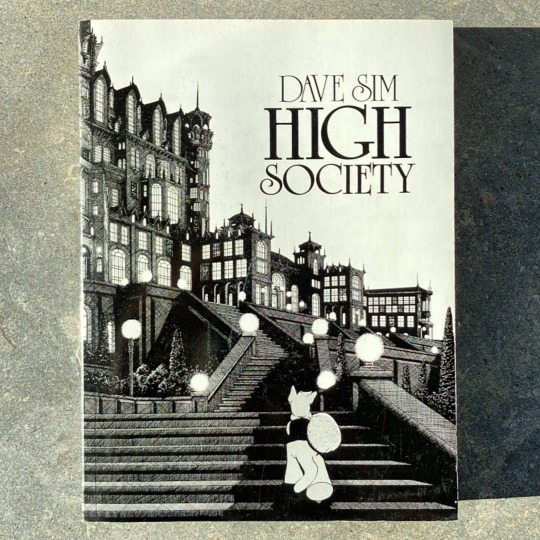
Dave Sim: High Society (1981-1983)
#dave sim#cerebus#high society#comics#graphic novel#political satire#marx brothers#election#moon knight
2 notes
·
View notes